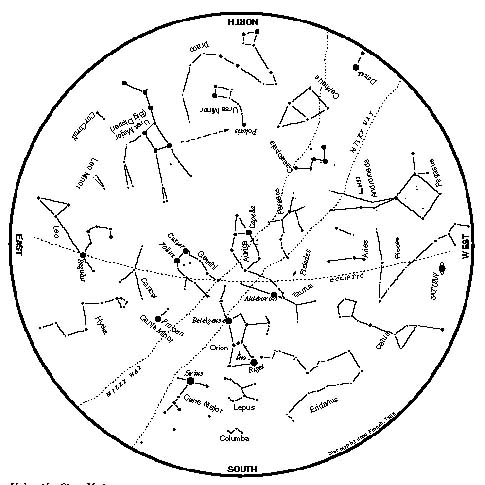

by Martin Ratcliffe
Finding your way around the sky is a little like finding our way around a new city. First you get to know the main thoroughfares, or in our case the most brilliant stars. Then after frequent visits to these bright friends, other patterns become familiar, until soon all the major constellations are known reasonably well. Then whenever a bright planet is around, it is fairly easy to follow. Learning the stars will take a little practice, much like driving around a new city, but they will stay with you for a lifetime.
In January and February, look for these planets in the night sky:
Mercury-Visible in the dawn sky during the last three weeks of January and the first week of February, Mercury passes three degrees north of Venus on January 12, but will appear much fainter.
Venus-A brilliant morning 'star' visible in the east before dawn.
Mars-Visible low in the southeast in late evening, and due south after midnight, Mars is a bright reddish-orange star among the stars of Virgo. Its easterly path against the stars from night to night will slow and turn westward in late February, due to the Earth catching up and overtaking the red planet. The next four months are the best time in two years to view Mars. Two NASA spacecraft are due to arrive at the planet next summer.
Saturn-Visible in the southwest after sunset. The rings can be viewed through any small telescope. Once the sky is dark, Saturn will be in line with the left side of the Great Square of Pegasus. On the evening of February 10 a four-day-old waxing crescent moon lies less than five degrees to the northeast of Saturn.
During late January and February Comet Hale-Bopp becomes visible among the stars of the Summer Triangle, Aquila and Cygnus, in the morning sky. This bright comet, perhaps the best in decades, is best seen from places away from any artificial lights (including your back porch light). The brightness of comets is notoriously difficult to predict, but this comet was discovered more than two years ago, and has been staying on schedule as far as brightness goes. In March it will be as bright as the brightest stars in the sky, though what kind of tail is on view will depend both on the comet, and your viewing location. It will be an easy object to see with the naked eye, and better with binoculars. By February 28 the comet, at first magnitude, should be as obvious as Deneb or Altair, two of the bright stars of the Summer Triangle currently visible in the morning sky. Watch the tail of this bright comet as it traverses the Milky Way from night to night.
Learn more about comets and where they come from in a new show now playing at Carnegie Science Center's Henry Buhl Jr. Planetarium: Comet: From Ice to Fire. Also, every Friday at 4:00 p.m. the planetarium presents Stars Over Pittsburgh, the show that is your weekly guide to the current night sky. For more information call 237-3400, ext.1132. For weekly updates on astronomical events, call the Carnegie Skywatch Hotline at 237-3400, or visit our web site at www.csc.clpgh.org.
Martin Ratcliffe directs the Henry Buhl, Jr. Planetarium and writes a monthly Sky Almanac column for Astronomy magazine. Skychart by John French, planetarium producer.